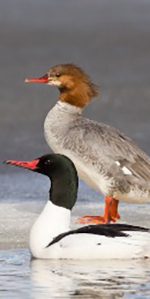| Common Merganser | ||
 |
Classification(s) : | Prey |
| Cat Name : | Duck | |
| Common Name : | Common Merganser | |
| Scientific Name : | Mergus merganser | |
| Other Name(s) : | ||
| Physical Description : | The largest of the three merganser species. The females have rusty-brown heads with ragged crests and a white chin patch, slaty-gray breast, back, wings and tail with white flanks and belly. The males are slightly bigger and in late summer molt males look like females in coloration except with a larger white patch on wing and a smaller crest. Both sexes have a long narrow serrated scarlet-orange bill with toothy projections along its edges that help the duck hold onto fish. In flight their profile is said to resemble a lawn dart. |
|
| Physical Statistics : | Length: 21.3 – 28 Inches (54 – 71 Centimeters) |
|
| Behavior : | Common mergansers are usually silent except during courtship or when alarmed. Females nest in cavities high above the ground, usually in trees. Young from several broods may join to form large aggregations called crèches and can survive independent of their mother and are flying after about two months. Common mergansers often swim together in small groups along the shoreline, where they dive frequently for food. |
|
| Social Organization : | Migratory Flock; |
|
| Approval Level : | Mod; These ducks are uncommon in the forest, perhaps following the river during their migrations. It is possible but unlikely that a pair may mate and a female raise young in the area, they prefer mature forests further north. | |
| Kill Difficulty : | Moderate; Common mergansers are large birds with the ability to deliver a solid buffet with their wings to an attacking cat. |
|
| Training Level : | Specialty - Duck; Hunters must carefully ambush them from the shore. Failure in a kill results in the bird either flying off, swimming away, or diving and vanishing into the water. |
|
| Hunting Tactic : | Waterfowl | |
| Food Quality : | High; Common mergansers supply a large amount of nutritous meat that can be shared amongst many cats. | |
